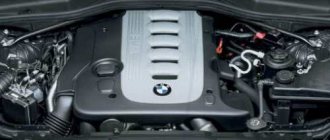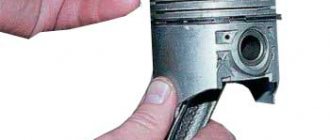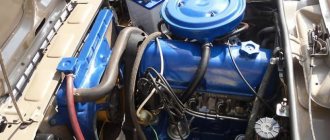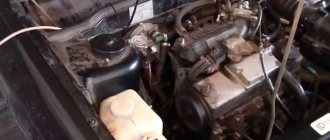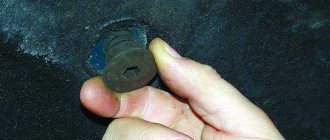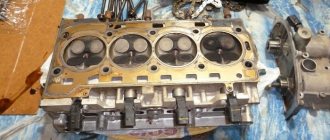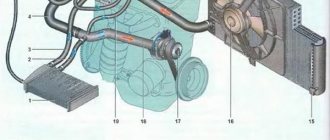Problems with cars are always unpleasant, and when the 8-valve engine on a Kalina, which has not yet driven 50,000 kilometers, fails, it is also insulting. But this problem does not appear immediately, but only when the engine warms up a little. Then the “engine malfunction” light starts flashing.
Turning off the ignition and restarting the car immediately solves the problem. Or rather, it stops for a minute, but then the games with nerves begin again.
The 8-valve engine on Kalina troubles only after the engine has slightly warmed up. In the very first minutes of starting, there is no such feeling: the power unit runs smoothly, the speed is kept at the same level. However, later the tachometer needle begins to twitch, rattling begins, and the engine itself begins to throttle and choke on fuel.
Finding the cause of the malfunction
The engine starts to stall when the fuel pump malfunctions and does not pump in the required amount of fuel, or when it does not burn completely. The substrate of the first case is not only the fuel pump itself, but also the conductive system. And the second reason may be related to problems with the ignition system, spark plug carbon, or improper operation of the engine valves.
If the fuel system is not working properly
, the feeling that the engine is stalling will develop a minute after the start, and then will only increase. If there is a narrowing of the pipeline, or there is no power to the fuel pump, such problems are not uncommon. You can check this after exposing the relay: start the engine, check the functionality of the pump and relay. In this case, the on-board computer will not show errors.
If there is a problem in the valve apparatus itself, in the spark plugs or in the ignition system, it will also manifest itself. Namely: the engine will start normally, but a moment later it will start to stall. Similarly, the power unit fault light should light up, because standard sensors perceive an excess (or lack) of fuel.
When such interruptions in the fuel supply occur, twitching develops, because the amount of gases produced in different engine operating cycles varies.
The engine is tripping: what is it?
Many people have heard the expression “move troit,” but not everyone always understood what it meant. Kalina’s engine has 4 cylinders, when one of them refuses to work, it turns out that the engine starts working on only 3 cylinders, hence the expression that the internal combustion engine is tripled, that is, it works on 3 out of 4 cylinders.
If there are 6 cylinders in a car and one of them does not work, then it turns out that the engine is “triple”, but no one uses this expression, since many even when one of the cylinders fails in a 6-cylinder internal combustion engine they say that it is “triple” .
Problems with valves on Lada Kalina
On the 8-valve Lada Kalina engine, the valves are less reliable than on the 16-valve version. This is a design flaw of engineers that car enthusiasts will have to deal with.
For diagnostics, you will need to at least look at the electronic control unit and compression in the cylinders. This will have to be done at a car service center, where computer diagnostics will initially be offered (see the article “What is included in engine diagnostics”).
Often, there is no result that can be relied upon to fix the problem, because the source of the breakdown is not in the sensors, but in the mechanical part of the car. Therefore, you will have to measure the compression in the cylinders. If it is normal, you need to remove the engine valve cover and inspect the gap between the valves. Its normal value is 0,2-0,35
.
It is important to set the valve clearance in this range, after which the engine stops running and the “engine malfunction” light goes out. By the way, valve adjustment for Kalina is required every 60,000-70,000 kilometers. But when gas is used as fuel, they need to be adjusted more often - every 20,000-30,000 km.
Similar problems
Other problems may also occur besides those described above. When the 8-valve engine on Kalina fails, the culprit of the problem may also be the ECU, which in this model is placed very poorly. If the owner did not wrap it with film, the contacts could oxidize, and conductivity through them could slow down or disappear altogether. The on-board computer will say the same, producing various errors.
Occasionally, it happens that antifreeze gradually seeps into the electronic control unit through a bunch of wires. Moreover, outwardly the ECU will look dry, although aggressive liquid gradually gets inside it. Therefore, the driver needs to open the block housing and inspect the contacts.
Causes of tripping at idle
Engine problems when idling
When you turn on the ignition and start the car, it idles intermittently. There may be several reasons for this . Let's consider the main problems that lead to this effect:
- Problems with spark plugs.
Diagram of possible spark plug faults
All these reasons can cause the engine to idle intermittently.
Trouble-shooting
The causes of the malfunction have been identified, and you can proceed to repair the car. To do this, it is worth checking step by step all the elements that could cause such an effect. So, let's look at the sequence of actions to troubleshoot the problem.
Spark plug
A breakdown, contamination or failure of this element can lead to the car idling intermittently, or, in popular parlance, “triple”. To eliminate the problem, you need to unscrew the spark plugs. How to do it:
- Remove the negative terminal from the battery.
Removing the battery terminal
We take out the high-voltage wires
Removing spark plugs using a 21 socket
That's basically all the dismantling operations.
In order to understand the condition of the spark plug, you need to visually inspect it: if it is too dirty, it means that they are being filled with gasoline and it cannot detonate normally, but if it is too clean, then not enough fuel gets into the engine.
Also, it is imperative to check the performance of the spark plugs. This is done on a spark plug stand, but if there is no such thing, then the old fashioned way, using a tester, we measure the resistance. It is imperative to measure the spark plug gap using a feeler gauge with a mark of 0.10 - this is the standard size that should be on all elements.
High voltage wires
The serviceability of high-voltage wires is checked by checking the resistance. Using a tester, each wire is “ringed” separately, where the value should be 5 ohms.
Checking high voltage wires
Ignition coil
If this unit fails or malfunctions, the effect of poor performance may occur not only at idle, but also when driving. It is worth checking the performance of the coil and replacing it if necessary.
Fuel system
The most common problems with engine rough idling occur in the fuel system. There may be several reasons for this, namely:
Checking and cleaning injectors yourself
Fuel pump filter clogged
It is worth checking all these elements for normal operation. If necessary, troubleshoot any problems that may arise.
Tips and tricks
Please note that in order to check the functionality of the ignition system, in some cases it is recommended to check the spark plugs for a spark
It is important to understand that if you simply unscrew the spark plug from the engine, the presence of a noticeable spark on the electrodes is not always a sign of complete serviceability
At the same time, checking the coils cannot be carried out by diagnostics or various tests, since in many cases the problem can be “floating”, and in the case of the test the readings will be normal. Finally, we note that practical operation identifies problems and malfunctions in the operation of ignition coils as one of the common causes of engine tripping after warming up.
In idle mode and at low speeds, the engine shakes: possible reasons for the unstable operation of the power unit. Self-diagnosis methods.
Why does the engine start to stall and the “check” light up on the dashboard: the main and most common reasons for the engine to stall and the “check” to light up.
For what reasons may misfire of the fuel-air mixture occur in one or more cylinders? Fault diagnosis, recommendations.
After switching to gas, the engine stalls, while running normally on gasoline: the main reasons for this malfunction. Diagnosis of problems, recommendations.
Engine trouble: symptoms. Why does tripping occur and how to find the reason why the motor starts to trip. Checking power, ignition, compression, etc.
Signs of a non-working cylinder (tribbing and vibration) of a diesel engine. Troubleshooting: compression, diesel injectors, glow plugs, injection pump and others.
“The engine stalls when cold” is a frequent Internet request and a common problem in Moscow. After starting the unit and reducing the speed, uneven exhaust is heard. But during warming up to the optimal temperature, the engine rhythm improves and no clear malfunctions are observed in the engine.
What to do in this case? How to identify the cause of a malfunction and not be deceived by a car service center? Click on any of the messengers below to find out 5 simple ways to avoid being scammed at service stations
Elimination methods
To eliminate the tripping effect on a vehicle, you need to have enough time, since it may take a whole day, as well as tools. To work, you will need a set of wrenches, screwdrivers and heads, as well as a multimeter. So, let's look at how to troubleshoot problems that have arisen.
The on-board computer recognizes a poor-quality mixture by the combustion process. But that's not the worst thing. Poor quality gasoline can clog elements throughout the system. The consequence of long-term use of this type of fluid can lead to the valve mechanism, as well as the pistons, burning out. In this case, major repairs become inevitable, since parts wear out at an accelerated rate.
If it is discovered that the gasoline is of poor quality, the motorist will face a whole range of repair operations, namely:
- Cleaning the fuel tank and replacing the filter.
- Cleaning or changing spark plugs.
- Dismantling and checking injectors.
- And finally, disassembling the cylinder head.
After cleaning, you need to fill it with high-quality gasoline and drive it. The CHECK icon should turn off on its own when high-quality fuel enters the system.
Checking the ignition coil and its circuits on VAZ 11183, VAZ 21116 and VAZ 11186 Lada Granta engines
Tool:
Tester
Parts and consumables:
- Probe with 1-2 W lamp
- Ignition switch contact group (if necessary)
- Ignition coil (if necessary)
- Bare wire
1. With the ignition switch OFF, disconnect the engine management system wiring harness connector from the ignition coil as described here.
2. To check the coil power circuit, connect the tester probes to the middle terminal of the harness block and the engine ground. When the ignition is turned on, the device should record a voltage approximately equal to the battery voltage.
Note:
If there is no voltage at the middle terminal of the wiring harness block, then the wire connecting the block to the ignition switch is probably faulty or the lock contact group is faulty.
3. To test the coil control circuits, you can use a probe with a 1-2 W lamp. Relieve pressure in the engine supply system and do not replace the fuel pump fuse. Connect the probe probes to the middle and one of the outer terminals of the wiring harness block. If the control (and power) circuit is working properly, the probe light should blink frequently when cranking the crankshaft with the starter.
Note:
Otherwise, check for a break or short to ground in the wire connecting the outer terminal of the block to the controller terminal.
4. Similarly, by connecting the probe probes to the middle and other extreme terminals of the block, check the other ignition coil control circuit.
5. You can check the serviceability of the ignition coil itself on the engine by disconnecting the wiring harness block and high-voltage wires from it. For clarity, we show the test on a dismantled coil. It is necessary to connect the device wires to the module contacts, which are located at the edges. That is, to the extreme left and right. Using an ohmmeter, check the circuit for an open circuit.
Note:
If the multimeter readings do not change after connecting the wires, this indicates that there is an open circuit in the circuit.
6. To check for breakdown (short to ground) of the primary windings, connect the tester probes to the middle terminal of the coil and to the metal part of the coil body.
Note:
If the circuit of the primary windings is working properly, the tester should record the value “infinity”.
7. To check for a break in the secondary winding of the ignition coil, connect the tester probes to the paired high-voltage terminals of the coil (terminals 1-4 or 2-3 cylinders).
Note:
For a working ignition coil, the tester should record a resistance of about 4.0 kOhm. If the secondary winding breaks, the tester will show “infinity”.
8. Check the other secondary winding of the ignition coil in the same way.
9. Check the secondary windings of the ignition coil for breakdown on the engine. Relieve pressure in the engine supply system and do not replace the fuel pump fuse.
10. To test, you will need two known good spark plugs. Tie the spark plug bodies together with a piece of bare wire (“massage”). Connect the paired terminals of the ignition coil with the spark plugs using serviceable high-voltage wires and place the spark plugs on the cylinder head cover.
11. Turn the crankshaft with the starter. If the ignition coil is working properly, sparks should regularly jump between the electrodes of the spark plugs.
Note:
To avoid electric shock, do not touch spark plugs or high-voltage wire tips.
12. Similarly, by connecting the high-voltage wires to the other two paired terminals of the coil, check the other secondary winding for breakdown.
The article is missing:
- Photos of parts and consumables
- High-quality photos of repairs
The engine stalls, the check light flashes or lights up: the main reasons
Let's start with the fact that injection engines are equipped with special catalyst devices for cleaning the exhaust.
At the same time, the catalytic converter is a rather vulnerable and at the same time expensive element, and all sorts of malfunctions in the engine create a risk of damage. As a rule, the check flashes when there is a risk of damage to the catalyst. In this case, the simultaneous tripping of the engine means that one or more cylinders are not working or are not working correctly. In practice, this means that the fuel in the problem cylinder does not burn completely, after which it enters the exhaust system.
As a result, the remaining unburnt fuel burns out in the area where the catalyst is located, since the temperatures there are very high. Fuel also gets on the catalyst itself, causing it to fail.
It becomes clear that the check often lights up when problems arise with the combustion of the mixture in the cylinders. It is not difficult to guess that such combustion can be disrupted for a number of reasons, ranging from problems with the ignition or fuel supply system to lack of air in the intake, air leaks, reduced compression in the engine cylinder, etc.
It should be added that the check also often lights up in the event of failure of any ECM sensors. One way or another, it is quite obvious that the “check” in the vast majority of cases indicates either problems with the electronic engine control system itself, or the risk of damage to the catalyst due to malfunctions of the internal combustion engine.
It is important to understand that the engine tripping indicates a non-functioning cylinder. In this case, the check is flashing not due to the failure of any ECM sensor, malfunction of the exhaust gas recirculation system or poor fuel in the tank, but rather signals to the driver about a direct threat to the catalyst
In a nutshell, fuel that is not burned and gets into the outlet causes a special sensor (lambda probe, oxygen sensor) to send readings to the ECU indicating deviations from the norm. The control unit begins to try to correct the situation, but taking into account the tripping, it is simply not able to adjust the operation of the motor so that everything returns to normal. As a result, fuel consumption increases, while the engine operates unstably, idle speed fluctuates, etc. In some cases, the motor “falls” into emergency mode.
This mode is necessary in order to minimize damage to the catalyst and the internal combustion engine itself. In practice, this is expressed in such a way that although the driver presses on the gas, the car in emergency mode with the “check” on still does not accelerate above 30-40 km/h, the crankshaft does not spin up, engine traction disappears, etc.
This feature of engine operation is primarily aimed at preventing burnout or melting of the catalyst. The catalyst itself consists of small honeycomb cells. If unburned fuel intensively enters the exhaust and burns out in the catalyst, the element will simply melt.
This melting will lead to the fact that exhaust gases will not be able to pass normally through the catalyst, that is, a plug appears in the exhaust pipe. Naturally, the engine will “suffocate”, power will drop, the engine may not start at all, etc.
Also, the catalyst will no longer be able to clean the exhaust, and toxicity will increase. There is only one way out in this situation - repairing the engine to eliminate the main cause of the engine tripping, and only then replacing the expensive catalyst with a new one. To minimize risks, a special program is programmed into the ECU, which involves operating the engine in emergency mode.
Diesel does not develop full power
Good day! Question for those who have encountered this problem. So I’ll start from afar to make the situation more clear. In general, I wrote earlier that I had a problem with the fact that at a traffic light the speed dropped to 500, then rose to 1200, then leveled off and everything started in a circle several times, and if I left it on hot, at idle, it could stall altogether, but it stalled softly, as if they had simply turned the key, and the canister purge valve was also clicking. I went through various diagnostics for a long time, in the end they found an air leak through the rubber bands of the receiver, changed the IAC, washed the throttle, changed the filter and mesh, after this replacement curve the fuel pump whistled, failures seemed to become less frequent, but it still stalled and only when it was hot, when I left it on single. As a result, I got to one diagnostician, he found a bent throttle valve, did the firmware and the car seemed to drive, the fuel pump stopped whistling after a month and a half. Everything seemed to be fine, but over time I began to notice such a thing that when the tank needle is in the red zone, the car seems to have been replaced, it starts to drive very cheerfully with less pressure on the gas pedal, plus there is clearer information from the pedal and less roar of the engine when accelerating. .e. even from the bottom (1.4 engine) it accelerates with a pleasant sound, and not with a fart that is about to die. BUT, as soon as you fill gasoline above the red zone, the car becomes sluggish, when accelerating in second gear, the car does not respond to how much the gas pedal is pressed, whether the pedal is to the floor, or until half the acceleration speed does not change, the speed rises somehow slowly, but if you pump the gas pedal with your foot several times, you can achieve a slight acceleration, but still not as much as on an empty tank (for the difference in weight of 30 liters, I think it’s stupid to say what will affect acceleration). Plus, when accelerating from the bottom, there is an unpleasant, sort of slightly farting sound from the engine (not the exhaust), it feels like it’s missing either air or gasoline. I drove like this for almost a year, I couldn’t find the reason, there were similar topics on the service and on the Internet, but there were no concrete solutions, most people simply don’t believe that the car can drive more vigorously on an empty tank. There is no air or other stuff in the tank. Recently the fuel pump whistled again, but the car drove briskly and on a full tank, so the pump was still original since 2009, I decided that the problem was in it and changed it, it seemed to start running, then I found a topic about the RTD and also changed it to catch up. The car came to life with any tank, drove like that for a week and a half and went to another city on the highway, everything was great, the acceleration was excellent, I didn’t even notice how quickly it picked up to 150. BUT, after driving about 70-80 kilometers, I began to notice that something was wrong again, when I was driving back I had to stoke in third to overtake
In general, now I don’t know where to dig, the car now drives according to its mood, no matter how many liters are in the tank, for example, I leave for work in the morning, it’s dull, the gas is on the floor, and like a pensioner it accelerates slowly, I leave it in the parking lot, in the evening I go out and it drives cheerfully with slipping in second and third gear, as if the engine had been changed. So far I can’t catch any pattern (if before it was based on the level of gasoline in the tank)
I also forgot to write that even after replacing the RTD with a hot one, in half the cases it starts poorly, you have to squeeze the gas. I only drive on gasoline; I don’t have gas equipment. Anyone who has encountered such a problem or knows what could be the reason, please tell me.
Faulty spark plug
An accompanying symptom that confirms the hypothesis that the cause is the spark plug is the fact that a cold engine trots more strongly. After warming up, the problem often disappears or becomes less pronounced.
First of all, you should pay attention to the color of the central electrode insulator. Determining a normally working spark plug is not difficult
A normal insulator is light or slightly brownish. If the color of the insulator is different from normal, then you need to find out why. Traces of oil or carbon deposits on the insulator indicate that an over-enriched mixture is entering the cylinder, which floods the spark plug, or it is “filled” with oil. As a result, normal sparking is disrupted.
The reasons for this may be different:
- the engine idles a lot when warming up;
- the check valve of the power supply system is faulty;
- low compression in the cylinder;
- impaired valve timing;
- malfunctions in the operation of injectors;
- failure of the oxygen sensor.
After the insulator, you should inspect the spark plug body. It must be intact, without chips or cracks
Particular attention should be paid to the presence or absence of vertical black stripes and black dots. If they are, the spark plug is broken and needs to be replaced.
Finally, the quality of sparking is checked. Moreover, simply connecting the side electrode to ground is not enough, in this way you can only check the performance of the spark plug. To understand how well the spark plug works, you need to hold it at a distance of one and a half to two centimeters from the ground and turn on the starter.
You can also find videos on the Internet with detailed instructions for checking spark plugs.



